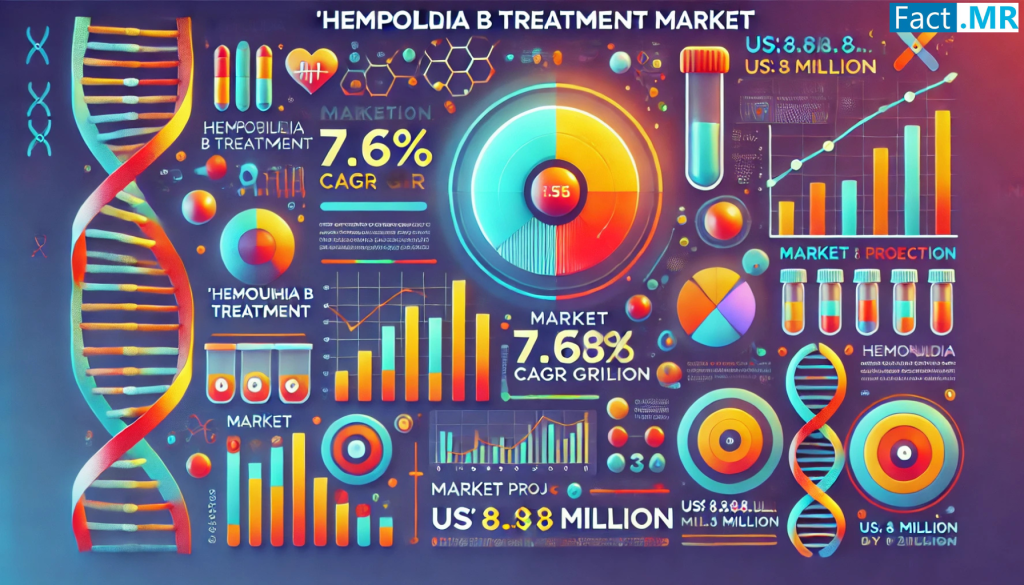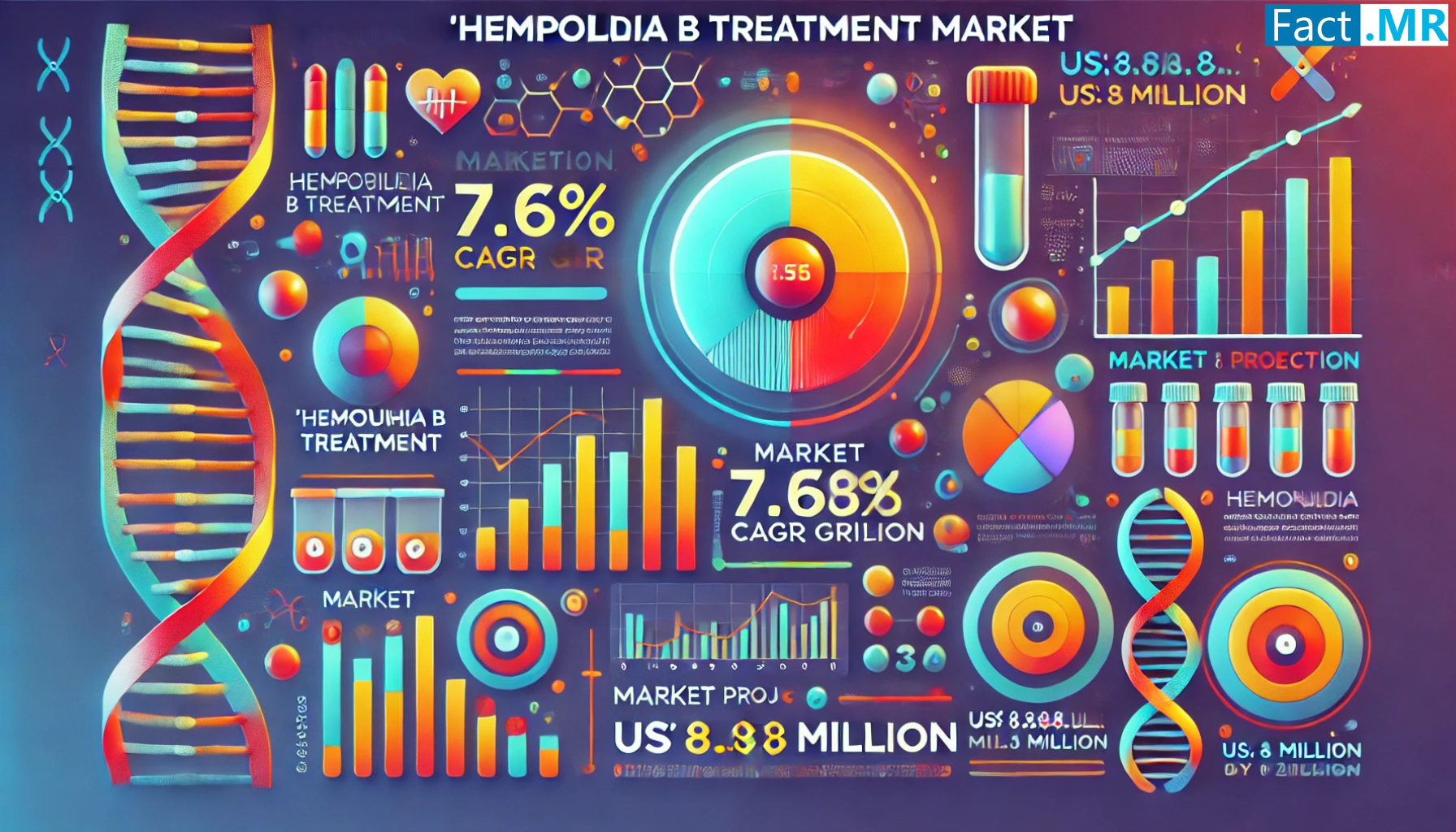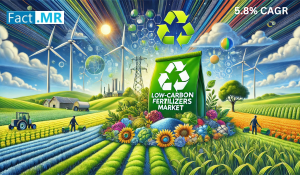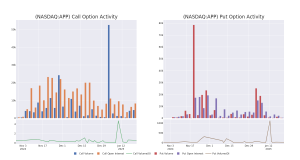
Rockville, MD, Nov. 25, 2024 (GLOBE NEWSWIRE) — According to Fact.MR, a market research and competitive intelligence provider, the global Hemophilia B treatment market is estimated to reach a valuation of US$ 4,291.8 million in 2024 and is expected to grow at a CAGR of 7.6% during the forecast period of (2024 to 2034).
The global hemophilia B treatment market is growing rapidly, powered by gene therapy innovations, extended half-life factor IX products, and an increased concentration on personalized care. The industry players can make the most of the advanced therapeutic developments of Hemgenix, a gene therapy approved by the FDA, and recombinant factor IX products, still one of the gold standards for hemophilia B treatment. The market, in addition, gets significant impetus in the substantial flow of government funds to treat different types of rare diseases, better infrastructure in the healthcare sector, and greater awareness associated with hemophilia B in the key regions of North America and Europe. Pressing demand for longer-acting, more potent treatments and a heavy flow of investments in biotechnology are some of the key drivers that are likely to lead to robust market growth over the coming decade.
For More Insights into the Market, Request a Sample of this Report: https://www.factmr.com/connectus/sample?flag=S&rep_id=10411
While several strategic partnerships between pharmaceutical firms and research institutions have been announced, the acceleration of treatment landscapes has been furthered. The collaboration between UniQure and CSL Behring on gene therapy production and distribution for hemophilia B led to the start of the launch of Hemgenix in 2022 as the first gene therapy for Christmas disease and is considered a historic milestone in medical science. It is a development that presents one treatment for several years, promising long-term benefits, hence gradually shifting the paradigm from regular infusions to potentially curative therapies. Increased regulatory approvals of gene therapies instill confidence in their wider adoption across the globe.
In addition, the transition to homecare settings and self-administration of factor IX concentrates has significantly empowered patients, engendering a greater level of adherence to prophylactic regimens and quality of life. Pharmaceutical firms are hugely investing in patient-friendly solutions, including extended half-life therapies that reduce infusion frequency from various times a week to once every two weeks for added convenience and greater effectiveness in treatment.
Hemophilia B, though a very rare disorder, is increasing at a gradual rate. According to recent accounts from the World Federation of Hemophilia, approximately 25,000 people worldwide suffer from hemophilia B. This ever-growing patient base with superior diagnosis capabilities and improved healthcare in developing countries will provide an upward thrust to seek treatment options.
In the emerging world, gene therapy will be a life-changing treatment for hemophilia B with the approval of Hemgenix, this may mean a single infusion could potentially provide a long-lasting solution without having to be on lifelong regular replacement therapy for factor IX. Ongoing research and clinical trials continue to refine the gene therapies, promising improved efficacy, reduced side effects, and lower treatment costs in the future.
Therefore, awareness campaigns and the development of patient advocacy organizations have provided better diagnosis rates, improvement in adherence to treatment, and accessing more care. Programs by the National Hemophilia Foundation and other international organizations are increasing support systems for patients suffering from hemophilia B, leading to better outcomes in treatment and creating demand in the market.
 Key Takeaways from Market Study
Key Takeaways from Market Study
- The global hemophilia B treatment market is projected to grow at 6% CAGR and reach US$ 8,965.8 million by 2034
- The market created an opportunity of US$ 1,086.4 million growing at a CAGR of 3% between 2019 to 2023
- North America is a prominent region that is estimated to hold a market share of 6% in 2034
- Predominating market players include uniQure (CSL Behring), Pfizer among others
- Hospitals under distribution channel type are estimated to grow at a CAGR of 7% between 2024 and 2034
“Hemophilia B treatment if on the verge of transformative growth with wide treatment modalities and huge investment” says a Fact.MR analyst.
Leading Players Driving Innovation in the Hemophilia B Treatment Market:
Key industry participants like uniQure (CSL Behring); Pfizer; Hoffmann-La Roche Ltd; Octapharma; CSL Behring; Sanofi; Bayer AG; Baxter; Swedish Orphan Biovitrum AB; Grifols International S.A; Kedrion Biopharma, Inc.; Biomarin Pharmaceutical, Inc.; Chugai Pharmaceutical; Biogen, Inc. etc. are driving the hemophilia B treatment industry.
Market Development
The companies are also extending their activities to developing regions like the Asia-Pacific, Latin America, and the Middle East, where few state-of-the-art hemophilia treatments have been available until recently, but new opportunities are opening up due to increasing healthcare investments. Expansion in these areas could result in the market share growing 20% by 2028. With the successful introduction of Hemgenix, among other gene therapy candidates under the pipeline, the manufacturing fraternity forecasts that the adoption of gene therapies will grow 10% in the next five years. This will cut overdependence on conventional factor IX replacement therapies and present long-term solutions to patients.
Companies will introduce new recombinant clotting factors with extended half-lives, increasing convenience and thus reducing treatment burden. This factor is expected to give a boost of 15% to the market share for this segment by 2030.
Enhanced partnerships with research bodies would mean several strategic collaborations with various research institutions and universities in the process of discoveries regarding the treatment of hemophilia B. This will ensure that approval processes by regulators are expedited and accelerate innovative therapies to market faster.
- In March 2023, the FDA granted Breakthrough Therapy Designation to Novo Nordisk for its novel extended half-life recombinant factor IX currently in development, which is expected to decrease the frequency of infusion to once every three weeks.
- June 2023- Pfizer announces the expansion in clinical trials for a new gene therapy candidate for hemophilia B, to be designed to deliver steady-state Factor IX expression levels with further improvement of long-term patient outcomes.
Get Customization on this Report for Specific Research Solutions:
https://www.factmr.com/connectus/sample?flag=S&rep_id=10411
More Valuable Insights on Offer
Fact.MR, in its new offering, presents an unbiased analysis of the global Hemophilia B treatment market, presenting historical data for 2019 to 2023 and forecast statistics for 2024 to 2034.
The study reveals essential insights on the basis of the by treatment type (recombinant factor IX concentrates, plasma-derived factor IX concentrates, gene therapy, and extended half-life Factor IX) by patient demographics (pediatrics, adults) by severity of hemophilia B (mild hemophilia B, moderate hemophilia B, and severe hemophilia B) by distribution channel (hospitals, specialty clinics, and online pharmacies) across major regions of the world (North America, Latin America, Western Europe, Eastern Europe, East Asia, South Asia, and Pacific, and Middle East & Africa).
Check out More Related Studies Published by Fact.MR Research:
Platelet-rich plasma market is slated to touch an impressive valuation of around US$ 1.5 Billion surpassing a CAGR of 12% during the assessment period.
Plasma fractionation market reached a valuation of US$ 32 Billion by 2022. Furthermore, across the 2022-2032 period of assessment, growth is expected to accelerate at a whopping 7.3% CAGR, reaching US$ 65 Billion.
Plasmapheresis market is evaluated at USD 1.3 Billion in 2022 and is forecast to outshine USD 2.6 Billion by 2032, mounting at a CAGR of 7.4% from 2022 to 2032.
Genetic testing services market size is predicted to increase from a valuation of US$ 3,956 million in 2023 to US$ 8,944.4 million by the end of 2033.
Gene delivery systems market currently accounts for a valuation of US$ 3 billion and is expected to reach US$ 4.1 billion by the end of 2027.
About Us:
Fact.MR is a distinguished market research company renowned for its comprehensive market reports and invaluable business insights. As a prominent player in business intelligence, we deliver deep analysis, uncovering market trends, growth paths, and competitive landscapes. Renowned for its commitment to accuracy and reliability, we empower businesses with crucial data and strategic recommendations, facilitating informed decision-making and enhancing market positioning. With its unwavering dedication to providing reliable market intelligence, FACT.MR continues to assist companies in navigating dynamic market challenges with confidence and achieving long-term success. With a global presence and a team of experienced analysts, FACT.MR ensures its clients receive actionable insights to capitalize on emerging opportunities and stay ahead in the competitive landscape.
Contact:
US Sales Office:
11140 Rockville Pike
Suite 400
Rockville, MD 20852
United States
Tel: +1 (628) 251-1583
Sales Team : sales@factmr.com
Follow Us: LinkedIn | Twitter | Blog

© 2024 Benzinga.com. Benzinga does not provide investment advice. All rights reserved.



